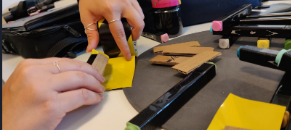
Shot In The Dark
Rules and Instructions
- The players sit down in front of each other by a table with the black wall between them.
- One player has all the coloured bricks in blue including the blue workers, and the other players has all the coloured bricks in red including the red worker. The players gets to choose if they want to be the black general or the white general.
- The players builds their own tower, they can built it however they want when it comes to the numbers, but the tower needs to look like a normal Jenga tower. Both players each have 27 bricks.
- When both players are done building their tower, it’s time to decide who beings to shoot. How you do that is with rock, paper and scissors – whoever wins gets to begin!
- Let’s say Red begins by saying a number from 1 – 27. Example: ”I’m shooting down your 15”.
Blue must then remove their number 15 from their tower. If Blue succeeds, then it’s Blues turn to shoot down a number from Reds tower.
When a brick has been shot down you say the number to the other player so they know you’re not cheating. Then you lay the brick to the side close to your workers where the other player cannot see them again.
- When it’s Reds turn to shoot, Red is allowed to repair after a number is said during the time Blue is trying to remove the chosen brick (but only if there has been bricks shut down). Red do NOT have to tell Blue which number Red is repairing. But Red MUST say that they decided to repair.
The cost of repairing is 1 worker! That worker is then OUT of the game and you lay the token down further away from the others. If Red does not repair in time while Blue has pulled out the chosen brick, then Red has to put back the brick to the side to use for later, but the worker is still OUT of the game.
- If a player happens to say a number again that is already shot down it skips the other players turn to remove a brick and says a number back to the other player instead. This means the player missed.
- If a total of 4 bricks fall at the same time including the chosen brick, the player loses. So for example if a total of 3 falls then the game continues, the players has to let the other player know which numbers has fallen.
It is NOT allowed to:
– look at each others towers.
– touch the wall.
– shake the table.
– ask which number has been shot down, players will have to remember this themselves.
– touch more bricks than the chosen one, however you are allowed to remove that brick however you like (not using objects).
Process
When we first got this assignment we did not have Battleship nor Jenga – it was pretty difficult coming up with an idea. So we had to improvise and try with different objects:
Styrofoam – Obviously this did not work at all since Jenga is all about the smoothness of the wooden bricks and also the weight of the bricks is SUPER important. But these were the first ”objects” we thought of and we tried it even though we knew it wouldn’t work whatsoever.
Markers – Since the Styrofoam was too light, we tried with something else we had that was a bit heavier. It ALMOST worked with the markers but first of all they were too big, also kinda light, and had some kind of design on them that didn’t make them as smooth as we wanted. So then we tried taping around the markers but that still did not show a good result.
Cardboard – Surprise surprise! The markers didn’t work either, we tried 3 small layers of cardboard taped together to make them smooth and perhaps heavier. It didn’t go the way we wanted, we couldn’t make it work with the edges being pointy from the tape. But, at least we tried.



After not having the actual Jenga game to try our ideas, rules and instructions. It took us a day to try it out – but eventually one of the members from our group brought Jenga with him and we had a full day of ideas popping out and we felt finished in a day (but of course we changed a lot during the week before the presentation).



During the games development we had a blast! There were barely any difficulties except for when we didn’t have either of the games from the start. But the group held together and we worked great as a team. We learned that roles are important, from the start we gave each member a role but at the end of the day we all helped each other and worked on everything together – which may not be such a bad thing.
We also realized that testing different prototypes of the game IS important, even though we knew from the start that the styrofoam, markers and cardboard wouldn’t work we still took the time to create these tests. We though about using a timer for the every turn, but since we have the repairing mechanic we didn’t see the use of the timer.
We’re extremely happy with the result, we had multiple students that wanted to play the game over and over again even when we weren’t present – which is a very good sign that your game is successful!
